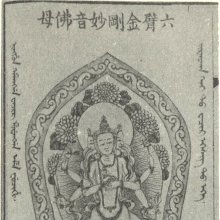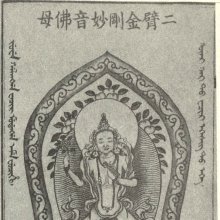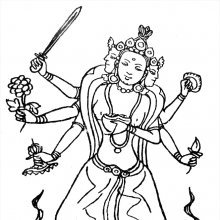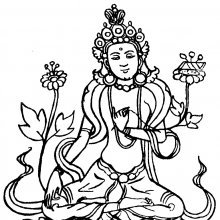Vajrasarasvati, Vajrasarasvatī: 2 definitions
Introduction:
Vajrasarasvati means something in Buddhism, Pali, Hinduism, Sanskrit. If you want to know the exact meaning, history, etymology or English translation of this term then check out the descriptions on this page. Add your comment or reference to a book if you want to contribute to this summary article.
Images (photo gallery)
In Buddhism
Tibetan Buddhism (Vajrayana or tantric Buddhism)
Source: archive.org: The Indian Buddhist IconographyVajrasarasvatī (वज्रसरस्वती) is one of the forms of Sarasvatī, as mentioned in the 5th-century Sādhanamālā (a collection of sādhana texts that contain detailed instructions for rituals).—Her Āsana is the pratyālīḍha; she has three faces and six arms.—The name Vajrasarasvatī is given to this goddess in order to distinguish her from the other four varieties of Sarasvatī, with four different names given in the sādhanas.
The Dhyāna (meditation instructions) of Vajrasarasvatī described in the Sādhanamālā as follows:—
[It has already been said that Sarasvatī has a form with three faces and six arms. In all other respects her form is identical with that of Mahāsarasvatī. The difference here is that her hair is brown and rises upwards, and she stands in the pratyālīḍha attitude on the red lotus. Three sādhanas in the Sādhanamālā are assigned to her worship, and according to these, she is red in colour, with the right and left faces of blue and white colour respectively. She carries in her three right hands the lotus on which is the prajñāpāramitā Book, the sword and the kartri, and in the three left the kapāla of Brahmā, the jewel and the cakra. Instead of the book on lotus and brahmakapāla she may also hold the lotus and the kapāla only.]

Tibetan Buddhism includes schools such as Nyingma, Kadampa, Kagyu and Gelug. Their primary canon of literature is divided in two broad categories: The Kangyur, which consists of Buddha’s words, and the Tengyur, which includes commentaries from various sources. Esotericism and tantra techniques (vajrayāna) are collected indepently.
Languages of India and abroad
Sanskrit dictionary
Source: Cologne Digital Sanskrit Dictionaries: Edgerton Buddhist Hybrid Sanskrit DictionaryVajrasarasvatī (वज्रसरस्वती).—name of a goddess: Sādhanamālā 326.1 etc.
Sanskrit, also spelled संस्कृतम् (saṃskṛtam), is an ancient language of India commonly seen as the grandmother of the Indo-European language family (even English!). Closely allied with Prakrit and Pali, Sanskrit is more exhaustive in both grammar and terms and has the most extensive collection of literature in the world, greatly surpassing its sister-languages Greek and Latin.
See also (Relevant definitions)
Full-text: Aryasarasvati, Sarasvati.
Relevant text
Search found 1 books and stories containing Vajrasarasvati, Vajrasarasvatī; (plurals include: Vajrasarasvatis, Vajrasarasvatīs). You can also click to the full overview containing English textual excerpts. Below are direct links for the most relevant articles:
The Indian Buddhist Iconography (by Benoytosh Bhattachacharyya)
Related products



